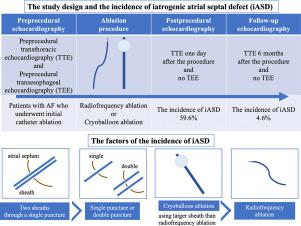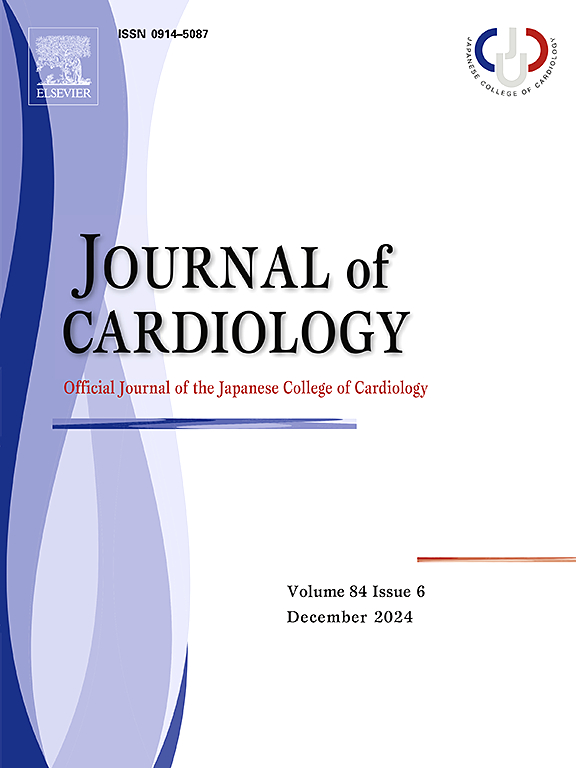导管消融术后持续性先天性房间隔缺损的发生率和预测因素。
IF 2.6
3区 医学
Q2 CARDIAC & CARDIOVASCULAR SYSTEMS
引用次数: 0
摘要
背景:心房颤动(房颤)消融术的左心房入路需要进行心房经皮穿刺,这可能会导致先天性房间隔缺损(iASD)。本研究旨在通过经胸超声心动图(TTE)评估导管消融术中 iASD 的发生率和预测因素,TTE 是一种在随访中经常使用的相对无创的技术:这项回顾性研究纳入了 2005 年 5 月至 2018 年 6 月间因房颤接受首次导管消融术的 639 名患者(489 名男性;60.2 ± 10.7 岁)。所有患者均接受了术前经食道超声心动图(pre-TEE)、术前 TTE(pre-TTE)和术后一天的 TTE(post-TTE)检查,并对 6 个月(6 M)后的 iASD 发生率、术前特征和手术方法进行了评估:42名患者(6.6%)通过术前 TEE 诊断出卵圆孔未闭 (PFO),11 名患者通过术前 TTE 诊断出卵圆孔未闭 (PFO)(占术前 TEE 中卵圆孔未闭患者的 26.2%)。在 597 例无 PFO 的患者中,497 例接受了 6 次 M-TTE 检查。59.6% 的患者通过后 TTE 观察到 iASD,4.6% 的患者通过 6 次 M-TTE 观察到 iASD。在单变量逻辑回归分析中,穿过室间隔的鞘管总直径(几率比 1.15,P 结论:iASD 并非罕见并发症。鞘管直径较大或一次穿刺有两根鞘管与 iASD 的发生率有关。本文章由计算机程序翻译,如有差异,请以英文原文为准。


Incidence and predictors of persistent iatrogenic atrial septal defect following catheter ablation
Background
The left atrium approach for atrial fibrillation (AF) ablation requires an atrial transseptal puncture that may cause an iatrogenic atrial septal defect (iASD). This study aimed to investigate the incidence and predictors of iASD in catheter ablation, assessed by transthoracic echocardiography (TTE), a relatively non-invasive technique frequently employed in follow-up.
Methods
This retrospective study included 639 patients (489 male; 60.2 ± 10.7 years) who underwent initial catheter ablation for AF between May 2005 and June 2018. All patients underwent preprocedural transesophageal echocardiography (pre-TEE), preprocedural TTE (pre-TTE), and TTE one day after the procedure (post-TTE). iASD incidence after 6 months (6M), preprocedural characteristics, and procedure methods were evaluated.
Results
Patent foramen ovale (PFO) was diagnosed in 42 patients (6.6 %) using pre-TEE and in 11 patients using pre-TTE (26.2 % of the patients with PFO in pre-TEE). Among the 597 patients without PFO, 497 underwent 6M-TTE. iASD was observed in 59.6 % of patients using post-TTE and 4.6 % using 6M-TTE. In the univariate logistic regression analysis, the total diameter of the sheath through the septum (odds ratio 1.15, p < 0.001) or two sheaths through a single puncture (odds ratio 4.17, p = 0.001) were independent risk factors on iASD incidence in 6M-TTE. iASD was also more likely to occur via cryoballoon ablation using a larger sheath than radiofrequency catheter ablation.
Conclusions
iASD was not a rare complication. A larger sheath diameter or two sheaths through a single puncture were associated with the incidence of iASD.
求助全文
通过发布文献求助,成功后即可免费获取论文全文。
去求助
来源期刊

Journal of cardiology
CARDIAC & CARDIOVASCULAR SYSTEMS-
CiteScore
4.90
自引率
8.00%
发文量
202
审稿时长
29 days
期刊介绍:
The official journal of the Japanese College of Cardiology is an international, English language, peer-reviewed journal publishing the latest findings in cardiovascular medicine. Journal of Cardiology (JC) aims to publish the highest-quality material covering original basic and clinical research on all aspects of cardiovascular disease. Topics covered include ischemic heart disease, cardiomyopathy, valvular heart disease, vascular disease, hypertension, arrhythmia, congenital heart disease, pharmacological and non-pharmacological treatment, new diagnostic techniques, and cardiovascular imaging. JC also publishes a selection of review articles, clinical trials, short communications, and important messages and letters to the editor.
 求助内容:
求助内容: 应助结果提醒方式:
应助结果提醒方式:


